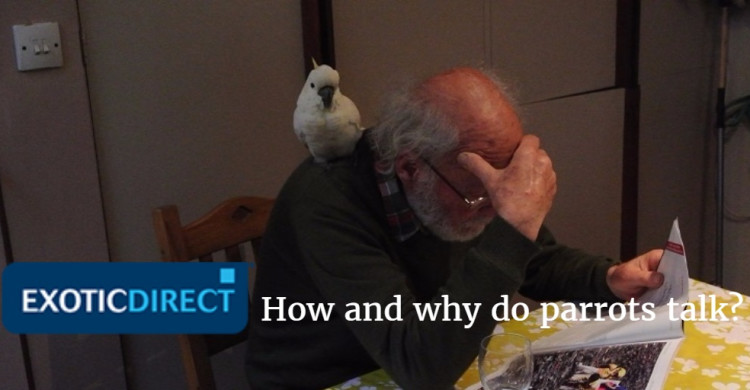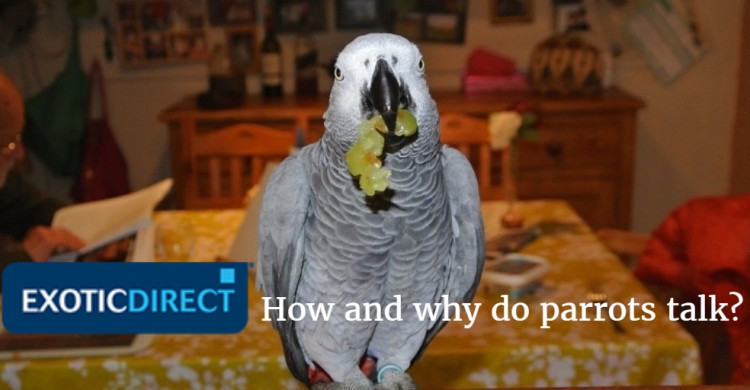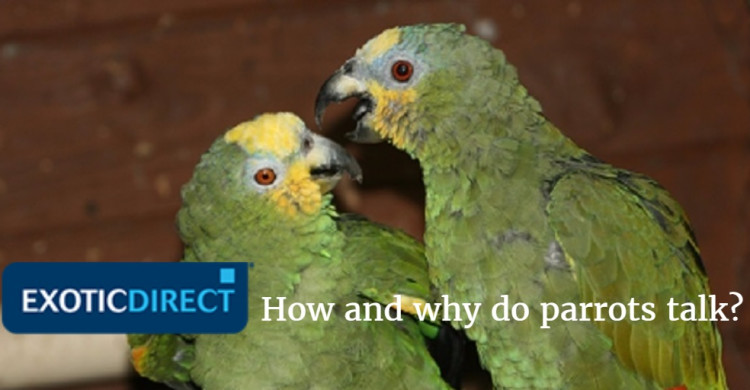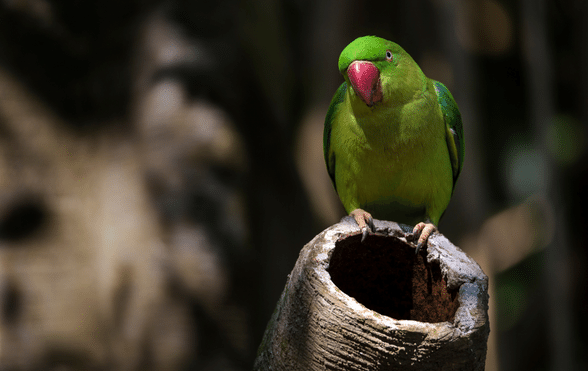Parrots don’t have vocal chords. Humans have a larynx; parrots have a syrinx. The same as do songbirds and members of the corvid (crow) family, mynah birds and the Australian lyrebird.
Is your parrot insured? Get a quote for up to £5,000 of vet fee cover, death and theft cover | We’ve been insuring exotic pets since 1996 | Check out our customer reviews on Feefo.
How do parrots talk | Why do parrots talk? | What is the best talking parrot? | Best small to medium sized talking parrot | How to train a parrot to talk | When will my parrot start to talk | Do parrots understand what you’re saying? |
How do parrots talk?
Parrots talk by modifying the air that flows over the syrinx to make sounds. The syrinx is located where the trachea splits into the lungs.
Parrots, particularly African Greys and members of the Amazon family are particularly good at imitating human words and sounds.
When I consider that a parrot has no lips or teeth the fact that both my Greys can imitate the timbre of my husbands voice never fails to amaze me.
Thinking of buying a parrot? Check this out…How much does it cost to own a parrot?
Why do parrots talk?
Pssitacines (the parrot family) and Passerines (the song bird families) use their voices to warn, to court, to communicate with their nestlings and to fight to defend a territory.
The majority of domesticated parrots are only a few generations removed from their wild cousins.
The sounds they make have a huge variation. Some are so pleasant to our ears that Mozart transcribed his pet starling’s voice into music.
Some like the shrieks of the Macaw or the Cockatoo family or some Conures can be extremely unpleasant. In fact I’ve known Cockatoo owners wear ear muffs!
Wild parrots use sound, whistles, chirps and squawks to communicate. How can the descendants of these same birds modify the sounds into recognizable human sounds? Ongoing research into birds’ vocal abilities and also their sense of rhythm is discovering more and more on this fascinating topic.
You may like to read: What your parrot can eat, diet and food ideas.

Fancy treating your parrot? Take a look at the Northern Parrots website, they sell a wide range of parrot supplies.
What is the best talking parrot?
The best parrots for talking are:
- African Greys
- Timneh Greys
- Yellow Naped Amazons
African Greys are particularly good for talking.
Find out how much it costs to buy an African Grey parrot.
African Greys and Amazons utilise the largest vocabulary of human words and Amazons are the best singers of our music. Although African Greys are fluent speakers, not many of them will speak on cue.
Magnificent macaws and beautiful cockatoos are not the best at talking. At most they’ll say a few words. But they are outstandingly clever.
Unless you have got a lot of spare time and a great deal of space, they’re not the most suitable pet parrots for the home environment.
My article Caring for a parrot – an owners guide offers guidance on what you need to know.
Best small to medium sized talking parrot
- The African Grey is the best medium sized parrot for talking.
- Some of the small parrots talk well. One champion budgie Puck (died 1974) was said to have had a vocabulary of 1700 words. But the budgerigar’s voice is high and piping and not easy to understand.
- Tame Cockatiels will also talk. But again they will have a limited vocabulary.
- Alexandrines
- Quakers
- Eclectus and
- Jardines will all pick up some phrases.
Not sure what kind of parrot to buy? Check out 5 Things you need to know about purchasing a bird
Is your parrot insured? Get a quote for up to £5,000 of vet fee cover, death and theft cover | We’ve been insuring exotic pets since 1996 | Check out our customer reviews on Feefo.
Alternatively you can call us on 0345 982 5505

How to train a parrot to speak
Parrots, like humans, are vocal learners, meaning they grasp sounds by hearing and then imitating them.
-
- Therefore you should teach your parrot like you would teach a baby.
- Repeat sounds, and praise them when they get something right. Your parrot will recognise when she’s pleased you, and want to repeat it.
- Steve Hartman, parrot expert, says “You should talk to your parrot regularly. Constant consistent verbal communication will help your bird develop into an intelligent, independent, self confident individual.
- Explain what you are doing – when you are cleaning the cage, cooking dinner, or watching television.”
You’ll notice that a baby parrot babbles like a baby. When baby says Da-da or Mum-mum, the parents are delighted and the baby learns. So you should think of the process like teaching a baby to talk.
Talking in your parrots language
Some carers try to use parrot language; it’s almost impossible. Try it for yourself. I have a communication whistle with my Greys. I’ve tried a few squawks with the macaws – not with much success.
Its a myth that whistling with your parrot hinders it speaking. But why should they copy human speech? Peer pressure, it turns out. Parrots naturally try to fit in, be it among other parrots or other people. In the wild, parrots use their vocal prowess to share important information with the flock. In a human household, a parrot will try to communicate with its huge, sometimes scary, flightless, flock members.
When will my parrot start to talk?
- Parrots start to use English from three months old to one year.
- Parrots already speaking, will increase their vocabulary throughout their lives given the right opportunities.
If you buy a baby parrot, one that was hatched in the nest will have been spoken to by its parents. A parrot who can communicate well in in her own parrot language, I believe, has a better base from which to acquire human language.
It’s alleged, though unproven, that the offspring of talking parrots may inherit the ability.
A word of warning here. Some parrots – even Greys and Amazons -won’t learn to speak human language and you should be prepared to accept that your funny, lovable acrobatic pet may never speak English. If you insist on a talking parrot it might be better to acquire one that already talks.
Do parrots understand what you’re saying?
I believe they do. For parrots, words may have associations rather than complex meanings.
So when your parrot says, ‘How are you?’ It’s not your health he’s asking about. He associates someone coming into the room with that phrase. In the same way, he’ll say, ‘Goodbye,’ when he sees you put on a coat.
Steve Hartman from the Parrot University states that:
“Understanding human language and being able to reproduce it are two entirely different skills. Parrots – just like children that are too young to speak – can and do understand a lot of what you are saying.”
I have found that entirely true when training my young macaw. He doesn’t speak more than a few words but understands much more. If I say ‘Bed time Benni’ too early he’ll immediately fly off his perch and land out of reach on the picture rail.
If I say ‘bed time, Benni’ at what he considers a suitable time around 9 pm, he’ll reply ‘step up,’ come back to his cage on my arm.
Talk as much and as often as you can to your parrot and he will be more likely to understand and more likely to use words appropriately.
Parrots communicate through body language
Parrots are capable of displaying extreme emotion. But unlike humans, parrots communicate their emotions mostly through body language.
If you want to communicate well with a parrot learn what its body language signals mean.
Humans also use body language to communicate. Since our vocabulary exceeds thousands of words – body language is often ignored.
For other mammals and birds, body language accounts for up to ninety percent of all communication.

Parrots can speak in context
Parrots will speak in whatever language is relevant to them, whether that be English, Japanese, Arabic or any other language they’ve heard spoken. Do parrots know what they are saying? Most parrot owners swear that they do.
During an hour-long Skype conversation I was having with an American Grey owner, Paula Feldman, neither her Grey, Rachel, nor my Grey, Artha, uttered a word. However, I believe that Rachel’s vocabulary of over 300 words, as transcribed by Paula, is quite accurate. Paula said, ‘As an English professor, I love being able to have a conversation with my companion animal.’
Like many Greys, if Rachel does not get what she wants, she insists. Her favourite food, corn-on-the-cob, is prepared in the microwave. When it pings, she often calls out ‘corn’. If corn isn’t forthcoming, she will sing in an operatic voice, ‘coo-r-r-r-r-n’.
Paula returned one day from the office and, as usual, greeted her Grey. ‘Hi, how are you, Rachel?’ The bird replied, ‘Incarcerated’. Paula told me, ‘I never taught her that word, but she’d have heard me use it occasionally. There are simply too many instances in which Rachel uses language appropriately for it to be mere coincidence’.
Sole birds are often reported to have vast vocabularies. Seventeen -year-old N’kisi, an African Grey, who lives in New York with her carer Morgana, has a vocabulary of over 1000 words. On one occasion, N’Kisi asked Jane Goodall, who was visiting the apartment, ‘Got a chimp?’ Morgana said that before Goodall’s arrival, she had explained to N’kisi about her work with chimpanzees.
Parrots can transpose!
What can be amusing is the way parrots transpose. I taught Artha Grey nursery rhymes. But she altered the words of Georgie Porgy, pudding and pie to ‘Artha- partha pudding and pie, kissed boys made cry.’
Other remarks I cannot think she understood but used them to elicit laughter and applause. To the question, how does the doggie go? She’d reply, ‘woof, woof, meow.’
Your parrot may not talk – but he may still understand you!
My own pair of wild caught Orange Winged Amazons (both now deceased in their forties and the hen at fifty) were not known for their talking ability.
However, someone had taught Archie in his years as a zoo bird to do the most convincing belly laugh imaginable.
These Amazons had lived for twenty years with a German-speaking couple. Although I never heard them speak a word of German, if any visitor spoke German to them, they’d bob up and down with excited interest.
Love your parrot for herself, not for whether she can talk
Bird owners often remark that one of their main reasons for buying a parrot was the possibility of communicating with the bird in his or her own language. Do remember that talking is only a small part of the joy of these amazing intelligent creatures.
I asked Dr Susan Friedman one of USA leading teachers of the science of behaviour for people, animals and birds whether any of her personal birds talked and she said: “all four of my parrots talk, but not often in English! Since parrots’ talking ability was one of their main attractions for me, it was a good lesson in unconditional acceptance and an opportunity for me to rethink what caring for parrots means. I understand now that meeting the needs of parrots as companion animals is very, very challenging and my focus is on arranging the environment for them to succeed in my care.”
And finally….
Alex The Parrot – Pioneer in Parrot Intelligence
The parrot who expanded our understanding of parrot intelligence was Alex, the African Grey whose name is an acronym for Animal Learning Experiment.
Alex, was the subject of a 30-year study by animal psychologist Irene Pepperberg, carried from 1977–2007.
In December 1980, Kathy Davidson, one of the laboratory students, took Alex to the washroom. Alex noticed the mirror for the first time. He cocked his head back and forth a few times to get a fuller look, and said:“What’s that?” “That’s you. You’re a parrot.” Kathy answered. “What colour?” asked the bird. “Grey. You’re a grey parrot, Alex.” And that’s how Alex learned the colour grey.
Alex was a captive-bred bird, purchased from a pet shop at about one year old. Although bought as a laboratory research animal, the relationship between Alex and Dr Pepperberg deepened.
‘He became my colleague.’ Dr Pepperberg said. She has never claimed that Alex used language in a human fashion. But the two-way communication code that developed between the bird and researchers, and later with the other African Greys who joined the lab, worked.
Alex provided incontrovertible proof to everyone but the most diehard sceptics that he could perform various cognitive tasks as well as the great apes, and at the level of a young child.
His astounding abilities were displayed through his use of language. Alex could count up to six, knew colours, shapes and qualities of objects. He could tell you what material an object was made of. Towards the end of his life, he appeared to have an awareness of the concept of zero.
Is your parrot insured? Get a quote for up to £5,000 of vet fee cover, death and theft cover | We’ve been insuring exotic pets since 1996 | Check out our customer reviews on Feefo.
Additional resources
Barbara Heidenreich has an instructive DVD available on Amazon called Teach your parrot to Talk

